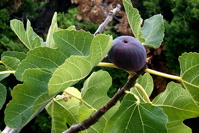Mustard Season
Just in time for Weekend Herb Blogging, hosted this week by the talented Pille, we celebrate the beginning of the fall and winter greens season with some heirloom lettuce and a great salad greens that is often overlooked: mustard!
The cool weather coming in is the best time for growing delicious green things for salads, sandwich layers, and garnishes. Our lettuces, which hid from the summer heat, are starting to peek out from where they self-seeded. In the meantime, we'll plant to make up the difference!
Pictured here, on top of some Early Girl tomatoes (which are ripening late, under floating row cover), are fresh leaves of Forenschluss and Cimmaron romaines, and a crinkly red mustard leaf.
Mustard is the great "sleeper green" of the instant gourmet and adventuresome home gardener. Leaf mustard, unlike mustard grown for seed or as a cover crop, has broad leaves that range from mildly zingy to mule-kick strong. The variety I chose, sheerly for robust good looks, is Red Giant, and falls somewhere between those two extremes. I find the leaves by themselves too strong, but they layer nicely between a couple of romaine leaves in a lunchtime sandwich. The zingy pick-me-up of mustard leaves can let one skip the prepared mustard or mayo, handy for a bag lunch brought to work.
If you can grow lettuce, you can grow leaf mustard. Look for it on racks of Botanical Interests gorgeous illustrated seed packets, where Giant Southern and Giant Red are prominently displayed, as well as Mizuna, a sawtooth-leaved oriental cooking mustard green. In your local Asian market, look for "Gai Choi". Mustards come in a gorgeous palatte of colors and textures, too. High Mowing's Organic mustards include the stunning Purple Osaka and their striking "Hotshot" mix.
I picked up six-pack sets of lettuces and mustards at our community garden's fall plant sale. Forenschluss, which means "Speckled Belly", is a beautiful variegated romaine with an upright, compact habit. The bronze tones of Cimmaron go very well with Forenschluss, so I've planted them in alternating rows in my garden.
Labels: heirloom, lettuce, mustard, weekend herb blogging
















